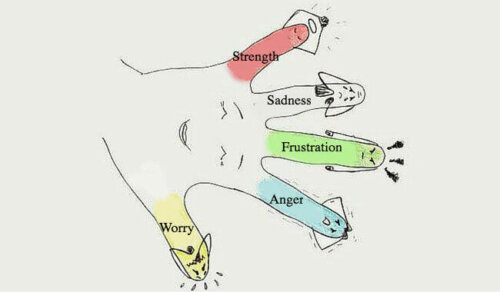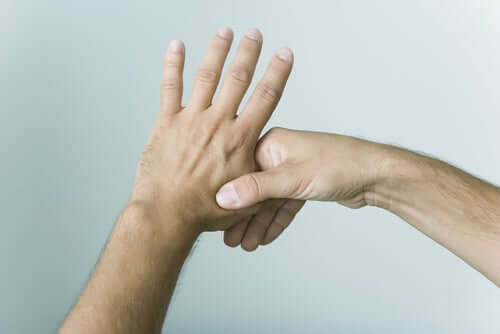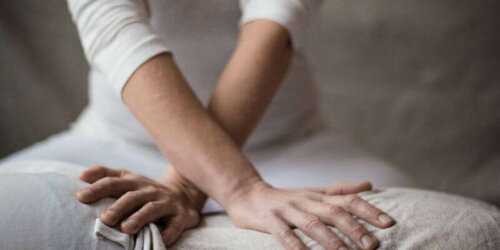The Japanese Method for Eliminating Stress

There are several methods for eliminating stress, that common enemy in everyday life. One of them is the so-called Japanese method, whose approach is based on acupressure, a well-known and increasingly widespread technique worldwide.
Acupressure is part of traditional Chinese medicine. It’s essentially a very simple exercise that uses the hands or fingers to exert moderate and specific pressure on various areas of the palm, sole, and even the ear.
It’s easy to learn and you can use it at any time. It also has a scientific basis and remarkable effectiveness, so it’s always a good time to implement new mechanisms to deal with the effects of moderate stress.
Nevertheless, and in case you perceive your stress levels persist over time, you should consult a specialized professional.
What the Japanese method for eliminating stress tells us
When combined with your daily obligations, exhaustion and fatigue can be very detrimental to your health. It would seem that stress is always more common than health and calmness.
Whenever things at work or at home have begun to stress you out, we recommend that you try this interesting Japanese technique to relax.

- In the hospital, the nurses were trained in this technique, which is included in what’s known as: Jin Shin Jyutsu.
- Jin Shin Jyutsu was intended to reduce stress in patients admitted to the hospital.
- The training course consisted of three two-hour sessions, where the nurses learned to apply acupressure to different parts of the patients’ bodies, especially the hands.
- The results were significant: people admitted felt more relaxed.
Theory and practice tell us that the Japanese technique to combat occasional or moderate stress is effective.
You might like: The Best Foods to Get Rid of Fatigue
How to use it for eliminating stress
You can use the Japanese method to eliminate stress in different ways. Let’s look at some exercises below. Take notes!
Pressure on emotions technique
The theory is that, by massaging or applying pressure to a particular finger, you may be able to help relieve a particular pain. To better understand how this works, you must first know of the healing powers of each finger.
- Thumb: worries, nerves, and stress
- Index finger: fear
- Middle finger: anger and rage.
- Ring finger: depression, sadness, and indecision
- Pinky: pessimism, lack of energy, and anxiety
The “scientific” explanation for this method is based on the fact that your hands are connected to your brain. Specifically, to the area that’s responsible for your emotions.
In order to apply this for eliminating stress, you need to put your left hand in a fist. Then, wrap the fingers of your right hand around it.
Put pressure on the specific finger related to your ailment or problem. If it’s stress, then you’ll be going for the thumb. Hold the pressure for about 30 seconds and rest another 30. Begin again as often as you like.
Eliminating stress with acupressure

There’s also another way that people work through their emotions using their fingers. It’s based on “Jin Shin Iyutsu,” which is a Japanese art form. It means something like “the art of happiness.”
- In this case, you massage the points on your hand as things occur. Thumbs and index fingers for concerns, middle fingers for anger, ring fingers for sadness, and pinkies for pessimism.
- Open one of your hands and pay close attention to the finger that is closely related to your situation.
- Press on both fingers for a few minutes using the thumb and index finger of your other hand. You can also close the finger in question in the form of a “locked” fist. Once you have done this, switch hands and repeat the exercise.
These techniques help you during times of stress or emotional upset. However, they could also aid in relieving physical ailments. Let’s see what each finger is for:
- Thumb: stomach and spleen. Headaches, stomach problems, and skin disorders.
- Index finger: kidneys and bladder. Muscle aches and digestive problems.
- Middle finger: gallbladder and liver. Menstrual pain, headaches, vision problems, circulatory issues, and fatigue.
- Ring finger: colon and lungs. Digestive upset and respiratory problems (especially asthma.)
- Pinky: heart and intestines. Bone problems.
Additional techniques for fighting and eliminating stress
It seems there are many effective techniques from Asia that aim to help people get into a “zen” state. That’s why most of the best exercises and methods for eliminating stress come from this part of the world.
If you’re very stressed out, in addition to trying the finger pressure technique, we recommend that you also try the following:
Yoga
The first record of this practice and life philosophy dates back to 3,000 years ago, on paintings that were found in India. Yoga is acclaimed for its ability to unite the body and the soul through meditation.
Several branches of yoga have spawned throughout history, but they all have the same purpose. To help you achieve a balance between your physical and spiritual beings.
Practicing yoga regularly could help promote weight loss, fight pain (especially back pain), tone your muscles, improve flexibility, and relieve depression and stress. Relaxation is achieved in various positions, according to each person’s needs.
Forest bathing

In order to practice this technique, known as Shinrin Yoku, you have to walk barefoot through a park or forest.
The idea is that walking through nature allows it to enter your body through your five senses. This practice improves your mood, creativity levels, and health.
Only pay attention to what’s around you and don’t look at your phone or focus your attention on anything other than nature.
If you do it in the garden of your house, you can enjoy a delicious cup of tea or fruit juice while you walk. You’re forbidden from taking your cell phone or your problems with you on your forest walks. The idea is that you enjoy the moment with your five senses.
According to studies, this also helps reduce blood pressure, cortisol levels (the stress hormone), and anxiety, while strengthening your immune system and improving cognitive function
You might like: Reduce Anxiety with These Five Calming Remedies
Tai chi
This Eastern discipline seeks to find the perfect balance between body and mind by applying slow but vigorous movements. Undoubtedly you’ve some people practicing this in a park before. It’s fun, plus it’s great for all ages.
Tai chi is a form of martial arts but it’s also an activity to help relax you. Some of its many benefits are stress relief, physical strength, increased flexibility, and the flow of positive energy.
Shiatsu

This is a Japanese practice that may help alleviate various types of ailments caused by stress, such as sore shoulders and a stiff back.
In Shiatsu, you exert pressure on several specific points of the body. Each of them is related to the central nervous system and vital organs.
Shiatsu could potentially help reduce tension, provide energy, eliminate toxins, regulate your blood pressure, and alleviate anxiety and sleep disorders.
Do-In
This practice was invented in China, and it aims to improve the elderly’s quality of life. It’s based on a series of breathing exercises that may help: reduce nervousness, encourage better balance, and help you achieve a sense of serenity.
It can also be used in your workplace during stressful times. Do-in not only has the potential to promote conscious breathing, but it could also aid in meditation, strengthening your muscles, restoring good sleep, and eliminating stress and tension.
Aikido
This is also a martial art. Unlike karate or taekwondo, however, Aikido promotes mental serenity and respect for others and rejects violence.
Movements are typically circular and may improve your ability to concentrate while balancing your mind, eliminating stress, and toning the muscles. Aikido translates to “the way of energy and harmony.
Don’t underestimate psychological help
When it comes to dealing with and managing conditions such as stress, depression, and anxiety, we have various approaches and methods, such as the Japanese method mentioned here.
Bear in mind that, although it may contribute to relief, it doesn’t mean you should rely solely on it to make yourself feel better. You should never underestimate the guidance and help that a psychology professional can provide.
These Eastern practices reflected here can be useful, but always as a complement to a healthy lifestyle and appropriate professional therapy.
All cited sources were thoroughly reviewed by our team to ensure their quality, reliability, currency, and validity. The bibliography of this article was considered reliable and of academic or scientific accuracy.
- Burmeister Alice (1998) Practical Jin Shin Jyutsu: Energise your body, mind and spirit the traditional Japanese way. Thorsons (New York)
- Yoshimura, M., Kurokawa, E., Noda, T., Hineno, K., Tanaka, Y., Kawai, Y., & Dillbeck, M. C. (2015). Disaster relief for the Japanese earthquake tsunami of 2011: Stress reduction through the Transcendental Medication® technique 1 ,2 ,3. Psychological Reports. https://doi.org/10.2466/02.13.PR0.117c11z6
- O’Connor, D. B., & Shimizu, M. (2002). Sense of personal control, stress and coping style: A cross-cultural study. Stress and Health. https://doi.org/10.1002/smi.939ç
- Park, J., Kitayama, S., Karasawa, M., Curhan, K., Markus, H. R., Kawakami, N., … Ryff, C. D. (2013). Clarifying the links between social support and health: Culture, stress, and neuroticism matter. Journal of Health Psychology. https://doi.org/10.1177/1359105312439731
This text is provided for informational purposes only and does not replace consultation with a professional. If in doubt, consult your specialist.








